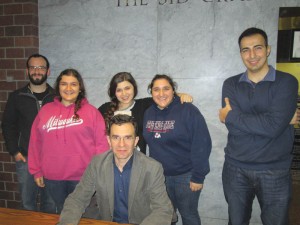Micheal Rettig
Staff Writer

It has been difficult for historians to reconstruct the daily lives of Armenians prior to the Genocide. Those who lived before 1915 could not conceive that their entire way of life was on the brink of extinction. Many of them felt no need to document their day-to-day lives, most likely imagining that they would go on in the same fashion for generations to come. Those who did write were often among the first to be targeted by the Turkish government, which subsequently arrested and killed many of the Armenian intellectuals. Much was lost during these years, making it hard for historians to reconstruct the lives of Armenians living in Turkey.
Dr. Vahe Tachjian, director of the “Houshamadyan Project,” has made it his life’s work to piece together what life was like for the Armenians living in the Ottoman Empire using primary sources. “I seek to show the inescapable value of Armenian sources to study Ottoman Armenians and the Ottoman Empire in general. The use and study of Armenian primary sources has for a long time been the missing link in Ottoman studies.”
In his lecture “Building the Model Ottoman Citizen,” presented at Fresno State on Thursday, January 29, Dr. Tachjian presented his research on daily life in Kharpert, based on the writings of two notable figures from the region: Donabed Lulejian and Hovhannes Bujicanian. Their articles, letters, and other publications were preserved and later published by their families, making them available for study. As Dr. Tachjian noted, “These sources open up a wide vista on the cultural, economic, political, social, and even personal events in the region.”
Focusing on Kharpert was fitting for this lecture, considering the sizeable population of Armenians from Kharpert living in Fresno. The community demonstrated their interest in this topic by attending in large numbers. Among the audience was the former Associate Justice of the Supreme Court of California, Marvin Baxter, who contributed an article about his ancestors to the Houshamadyan website.
Kharpert was known for being the center of education and enlightenment for the Armenian people. The Protestant missionaries greatly contributed to this reputation by establishing the Euphrates College in 1878, from which both Hovhannes Bujicanian and Donabed Lulejian graduated. The Euphrates College became a stepping stone for many Armenians to further their education in Europe. Bujicanian was able to study philosophy in Edinburgh and return to Armenia to teach while Lulejian was able to pursue his education in America.
Dr. Tachjian recounted the calm before the storm, as the Young Turks came to power with the support of the Armenians. Bujicanian was a strong supporter of the Young Turks and hoped that they would bring a better life for the Armenians. The new sense of freedom and change among the Armenians resulted in more homes with windows and double-stories. Their enthusiasm was soon crushed when news of the Adana massacres spread.
Bujicanian quickly became disillusioned with the new government and wrote to his friend in America that Ottoman Armenians were ready “at any minute for meaningless death.” Both Bujicanian and Lulejian were killed during the Genocide, but their thoughts live on through their writings.
Dr. Tachjian collects such writings for his website, titled “Houshamadyan: A Project to Reconstruct Ottoman Armenian Town and Village Life” (http://www.houshamadyan.org). He believes that “despite the wealth of materials written in Armenian, the perspective of Armenian authors on their own issues and daily life is not represented.” This website is meant to give voice to Armenian primary sources and better describe what their lives were like. He concluded his lecture with a guided tour of the site, which includes pictures, articles, videos, maps, and more, for the purpose of reconstructing the lives of Armenians before the Genocide. Visitors to the website are able to find different cities in Armenia and easily learn more about the regions various characteristics; such as religion, sports, and economy. Dr. Tachjian led the audience to the “sports” section of the website, which had descriptions and pictures of various games and activities that Armenian kids played.
Houshamadyan.org relies on researchers, such as Dr. Tachjian and his colleagues, to consolidate primary sources with the purpose of giving the visitor a glimpse at what life was like in Historic Armenia before the Genocide. This is an important resource for Armenians to discover what life might have been like for their ancestors. Old Armenian games and histories are resurrected and made available after having been tragically forgotten after the Genocide.
 Hye Sharzhoom Armenian Action
Hye Sharzhoom Armenian Action